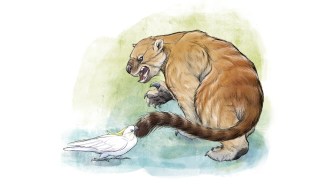Scientists willing to drive boats and cars in convoluted patterns say that spiny lobsters are the first animals without backbones to pass tests for the orienteering power called true navigation.

This capability lets homing pigeons and a few other animals figure out not just compass orientation–which way is north–but also their current address on the planet, explains Larry Boles of the University of North Carolina at Chapel Hill. Some birds, turtles, and salamanders can get back on track even after researchers enclose them in windowless containers and move them by a twisted route to an unfamiliar place. Bees and ants, however, get lost. People generally succeed at similar challenges only with the help of maps, compasses, and informative bystanders.
Experts on the Caribbean spiny lobster (Panulirus argus) have recorded occasional tales of its superior navigation, and now systematic tests have confirmed them, says Boles. The new experiments also suggest that the lobsters manage their remarkable feat by sensing their location within the magnetic field of Earth. Circuitous driving didn’t fool animals transported to a new spot, but altering the magnetic field of the destination did, report Boles and his North Carolina colleague Kenneth Lohmann in the Jan. 2 Nature.
“A lot of people, even scientists, tend to think of invertebrates as lower animals,” says Boles. “We now have an example in an invertebrate of the most sophisticated navigation an animal can do.”
The Caribbean spiny lobsters dwell in the western Atlantic Ocean from Bermuda to Brazil. To see whether they have a homing ability, Boles caught more than 100 lobsters in different locations and transported them for about an hour in various deceptive ways to a test site. He kept the lobsters in opaque, rope-suspended compartments, and for some, he dangled magnets inside the travel containers.
While transporting the lobsters, he followed routes with “ridiculous contortions,” he says. “I was worried about attracting attention from the marine patrol looking for drunken boaters.”
When Boles finally reached one of his two test sites, he blindfolded each lobster by applying removable caps molded out of dental amalgam to fit over the eye stalks and tethered the animal in a tank with a slippery floor. It then trudged in a direction close to its homeward bearing. For example, lobsters dislocated 250 from north oriented themselves, on average, at an angle of 222. The magnetic conditions during transport didn’t influence this behavior.
To explore what cues the lobsters might be using, Boles and Lohmann settled each animal into a device that recreates the magnetic field of another place. Lobsters in a false field mimicking conditions 400 kilometers north of their home walked south, and counterparts in a false southern field walked north.
A specialist in animal navigation, John Phillips of Virginia Tech in Blacksburg calls the findings “very exciting.” Recent work suggests that vertebrates can use two separate systems for detecting their magnetic environment. Phillips suspects that the lobster system evolved independently and will make an interesting comparison.
****************
If you have a comment on this article that you would like considered for publication in Science News, please send it to editors@sciencenews.org.







